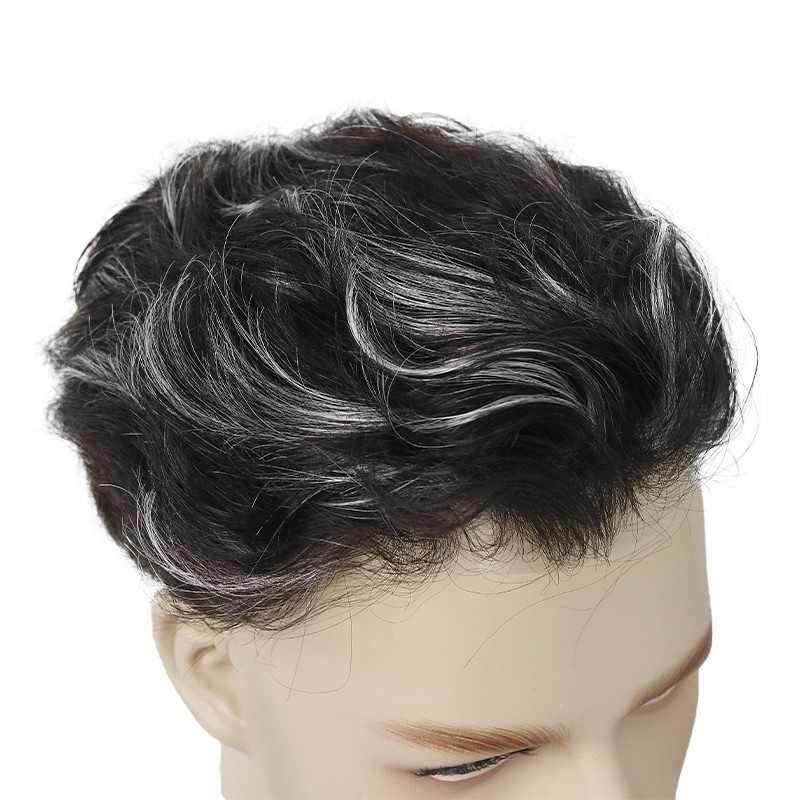People looking for a natural and unnoticeable remedy for hair loss sometimes choose for a thin skin hair system. This hair replacement alternative smoothly mixes with existing hair to provide the impression of actual hair growth.
Preparing for Application: Cleanse and Dry
Wash and Condition Your Hair
- Begin by washing your natural hair with a gentle shampoo to remove any dirt, oil, or styling products. Avoid using conditioner at this stage as it can create a slippery surface that may hinder the adhesive’s effectiveness.
Dry Your Hair Thoroughly
- Use a clean towel to gently dry your hair, ensuring that it is completely dry before proceeding with the application. Moisture can prevent the adhesive from properly adhering to your scalp, compromising the bond.
Choosing the Right Adhesive

Selecting the Appropriate Adhesive Type
- Thin skin hair systems can be attached using either liquid adhesives or tapes. Liquid adhesives provide a stronger and longer-lasting hold, while tapes offer a more flexible and easy-to-remove option.
- Discussing your preferences and lifestyle with a hair specialist can help determine the best adhesive type for your needs.
Perform a Patch Test
- Before applying the adhesive to your scalp, perform a patch test on a small area of your skin to check for any adverse reactions or allergies. This step is crucial to ensure your safety and comfort during the application process.
Applying the Thin Skin Hair System

Trimming and Shaping the Hair System
- If necessary, trim and shape the thin skin hair system to match the desired hairline and hairstyle. This step ensures a natural and seamless integration with your existing hair.
Preparing the Scalp
- Cleanse your scalp with an alcohol-based scalp cleanser to remove any oils or residues that may interfere with the adhesive. Ensure that your scalp is clean and dry before applying the adhesive.
Applying the Adhesive
- For liquid adhesives, use a small brush or applicator to apply a thin and even layer of adhesive onto your scalp. Avoid getting the adhesive on your natural hair or the hair system to prevent damage.
- For tapes, carefully peel off the backing and apply the tape along the perimeter of the hair system.
Positioning the Hair System
- Gently place the thin skin hair system on your scalp, aligning it with your natural hairline. Press down firmly to secure the bond.
Bonding Time
- Follow the manufacturer’s instructions for the recommended bonding time. This allows the adhesive to set properly and ensures a strong and reliable hold.
Styling and Blending

Styling Your Hair System
- Once the hair system is securely in place, style your hair as desired. Thin skin hair systems can be styled just like natural hair, including brushing, curling, and using hair products.
Blending with Your Natural Hair
- If necessary, blend the hair system with your natural hair by using a comb or your fingers to create a seamless transition. Styling your hair in layers can help achieve a more natural and integrated look.
Maintenance and Care

Regular Cleaning
- Clean your thin skin hair system regularly with a mild shampoo and conditioner. Gently lather the shampoo on the hairpiece, avoiding harsh scrubbing that could damage the delicate thin skin material.
Proper Adhesive Removal
- To remove the hair system, use an adhesive remover specifically designed for thin skin hair systems. Apply the remover to the edges of the hairpiece to loosen the bond, then carefully lift the hair system off your scalp.
Cleaning and Storing
- After removal, clean the hair system with a gentle shampoo and conditioner, then allow it to air dry. Store the hairpiece in a cool and dry place to maintain its quality and shape.
Extending the Lifespan of Your Thin Skin Hair System
Avoiding Excessive Heat
- Limit exposure to direct sunlight and excessive heat sources, as they can weaken the adhesive and cause premature wear and tear on the hair system.
- When using styling tools such as hair dryers, curling irons, or straighteners, ensure that the temperature setting is moderate to prevent damage to the thin skin material.
Protecting from Moisture
- While thin skin hair systems are designed to be water-resistant, it is essential to avoid prolonged exposure to water, especially in chlorinated or saltwater environments.
- Consider using a shower cap or hair wrap during swimming or taking baths to protect the hairpiece from excessive moisture.
Regular Maintenance Appointments
- Schedule regular maintenance appointments with your hair specialist to ensure that the hair system is in optimal condition.
- During these appointments, the hairpiece can be professionally cleaned, repositioned if necessary, and any necessary repairs or adjustments can be made.
Overcoming Challenges and Addressing Concerns
Itching or Discomfort
- Some individuals may experience mild itching or discomfort when first wearing a thin skin hair system. This is normal and usually subsides after a few days as the scalp adjusts to the hairpiece.
- If the itching persists or becomes severe, consult your hair specialist for advice on how to alleviate the discomfort.
Dealing with Hair Shedding
- Like natural hair, thin skin hair systems may experience minimal shedding over time. However, excessive shedding could indicate improper care or adhesive issues.
Maintaining Confidence and Self-Esteem
- Some individuals may initially feel self-conscious or uncertain about wearing a hair system. Remember that hair loss is a common concern, and opting for a hairpiece is a personal decision that can greatly enhance your confidence and self-esteem.
The Versatility of Thin Skin Hair Systems
For Different Hair Types
- Thin skin hair systems are suitable for individuals with various hair types, including straight, wavy, or curly hair.
- The customizable nature of these hairpieces allows for seamless integration with any hair texture, providing a natural and cohesive appearance.
Various Hair Lengths and Styles
- Thin skin hair systems are available in different hair lengths and styles, offering endless possibilities for your desired look.
- Whether you prefer short, medium, or long hair, you can easily find a hair system that matches your style preferences.
The Emotional Impact of a Natural-Looking Hair System
Restoring Confidence
- For many individuals experiencing hair loss, wearing a thin skin hair system can be a life-changing experience, as it allows them to regain their confidence and feel more comfortable in their appearance.
- The ability to style and maintain the hair system on their own terms empowers individuals to present their best selves to the world.
Embracing Self-Expression
- With the opportunity to experiment with different haircuts and appearances provided by a thin skin hair system, people may express their own personalities and sense of style.
- Feeling confident in oneself may have a positive emotional influence on a variety of facets of life, boosting self-esteem and enhancing general wellbeing.
Conclusion
A thin skin hair system is a versatile and natural-looking solution for individuals experiencing hair loss. You may achieve a flawless and long-lasting integration with your natural hair by following our thorough step-by-step guidance and taking into account the necessary maintenance and care. Thin skin hair systems provide users the opportunity to reclaim their self-esteem, embrace their individual style, and benefit from the changing qualities of having a full head of hair. Whether you choose a short, medium, or long hairstyle, a well-maintained hair system helps you to confidently face each day with a new sense of confidence and self-assurance. A qualified hair expert may assist you in getting the desired look and regaining your sense of confidence. Just keep in mind that selecting the appropriate hair system may need some trial and error.




